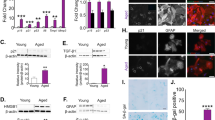Summary.
Introduction. The extracellular effects caused by advanced glycation end products (AGEs) themselves formed by the Maillard-reaction from proteins and sugars, are well known. Less is known about the effects of AGEs on cellular function. Cellular dysfunctions accumulate with increasing age and can be found as a pathogenetic principle of different diseases where AGEs are involved. The causal mechanisms of these cellular dysfunctions are not fully understood.
Material and methods. AGEs effects were examined in cell culture using video microscopy, immunhistochemistry, flow cytometry and biochemical methods in neural (NG 108-15) and glial (primary culture of astrocytes) cells.
Results. AGEs can bind to the cell surface of neural and glial cells. AGEs induce an altered distribution of vesicles and a statistically significant reduction in the velocity of microvesicles. The proteins dynamin 2 and clathrin, which are an important part of the transport apparatus, show changes in intracellular distribution similar to that of microvesicles. The immunoreactivity of dynamin 2 in AGE-treated cells is increased after AGE-incubation. After incubation durations of 2 h, 6 h and 12 h we found an increase (maximum <$>+<$>34.6%) of the relative fluorescence intensities of dynamin 2 in the AGE-BSA treated cells in comparison to the control cells (BSA). Using flow cytometry we found a minimal increase (14.4%) in clathrin immunoreactivity after 2 h incubation with 500 nM AGE-BSA. The non-quantitative western blot showed no difference of the electrophoretic behaviour of both dynamin 2 and clathrin in AGE-BSA-incubated cells (2 h, 500 nM) and in control cells (2 h, 500 nM BSA-incubation). The incubation with AGE-BSA up to a concentration of 500 nM in culture was not followed by apoptotic or necrotic cell death.
Discussion. We could show defined effects on the cells induced by incubation with AGEs. One of the effects is a significant reduction of the velocity of microvesicles, the reason for this is unclear. It could be due to disturbed calcium metabolism or caused by microtubuli-changes. The aggregation of intracellular microvesicles could be the result of an altered binding-behaviour of the vesicles or the destruction of the transport apparatus. The proteins dynamin 2 and clathrin, which are involved in transport apparatus, show changes in intracellular distribution indicating a breakdown of the normal cellular distribution system. The current results may contribute to the understanding of the pathologic processes in the cell in Mb. Alzheimer and other neurodegenerative diseases, where AGEs-accumulation can be found in tissues.
Similar content being viewed by others
Author information
Authors and Affiliations
Additional information
Received January 7, 2003; accepted June 10, 2003 Published online August 13, 2003
Rights and permissions
About this article
Cite this article
Reber, F., Reber, U. & Funk, R. Intracellular changes in astrocytes and NG 108-15 neuroblastoma X glioma cells induced by advanced glycation end products. J Neural Transm 110, 1103–1118 (2003). https://doi.org/10.1007/s00702-003-0031-9
Issue Date:
DOI: https://doi.org/10.1007/s00702-003-0031-9




